Have you considered starting a podcast? Podcasting is a great way for influencers and bloggers to share their wealth of knowledge. While you can easily share information on Instagram and your blog, having a podcast will help you stand out and differentiate yourself from the competition. And when done well, your podcast will help you engage with the harder to reach audiences, like the larger influencers or bloggers within your niche. If podcasting is in your future plans, you may feel overwhelmed with the process. This post is for you if you’re wondering where you even begin the launch process. In this post, I’ll walk you through everything you need to know to take your podcast from planning to publishing. Here are the 20 steps for starting a podcast.

20 Steps for Starting a Podcast
The process of starting a podcast is fairly similar to starting a blog. Although the medium in which you deliver your content is different, gaining clarity and niching down is essential before you launch your show. In order to start a successful, popular podcast, you first need to…
Step 1: Figure Out Your “Why”
Why are you starting this podcast in the first place? It seems like a pretty easy question but your answer will ultimately be the driving force behind the entirety of your show. Recording a podcast takes a lot of time, work, and energy. And if you’re not clear on your “why”, the process can be quite unenjoyable.
Getting crystal clear on your “why” will establish your authority as a podcast host. It’ll also help you speak directly to your podcast listeners while delivering both value and entertainment. The “why” behind your podcast will hold you accountable by motivating you to show up for your audiences consistently.
Step 2: Identify Your Target Audience
Once you’ve figured out your “why,” you need to identify who your podcast is for. Who are your ideal podcast listeners? For instance, my podcast — Her Life, By Design — is geared towards aspiring female entrepreneurs in the influencer, blogging, and online space. Having a target audience in mind helps you steer your content in the right direction.
Try getting to know your target audience and ideal podcast listeners as intimately as possible. Figure out details like their demographics, pain points, and what their hobbies are. And before you sit to record a podcast episode, ask yourself “would my ideal listener listen to this?”
Step 3: Put Value First and Foremost
Before you plan your podcast episodes, you need to consider the value you’re offering your listeners. Providing value, entertainment, and inspiration will give your target audiences a reason to tune into your show. Brainstorm a few episode ideas — what would each individual episode leave your audience with? Will they walk away with actionable tips and inspiration? Take a look at any popular podcasts on Apple or Google Podcasts. Each podcast episode is either packed with information, or they entertain their listeners through engaging stories and topics. When you make value the key component of your podcast, you’ll create a community of loyal listeners who will keep coming back for more.
Step 4: Name Your Podcast
This step might just be the most difficult part of starting a podcast. Just like choosing a name for your blog, your podcast name needs to encompass several things. First of all, your podcast name needs to be easily searchable. But simply calling your podcast what your target audience are typing into the search bar might be dull and boring. Get clever and descriptive with your name. For instance — Her Life, By Design — speaks directly to ambitious females who are looking to create or design the life and career of their dreams. Another great example would be Brittany Krystle’s Beyond Influential podcast. Brittany’s show dives deep into the power of influence through conversations with entrepreneurs, thought leaders, and creatives.
Here are a few things to keep in mind when coming up with a name for your podcast:
- Searchability – does your title include keywords relating to your target audience?
- Catchiness or cleverness – is your title clever, catchy, and easy to remember?
- Clarity – is your title clear enough or does it require a tagline?
- Length of your title – is your title too long and wordy or does it easily roll off the tongue?
- Using your name – does it make sense to use your name in the title?
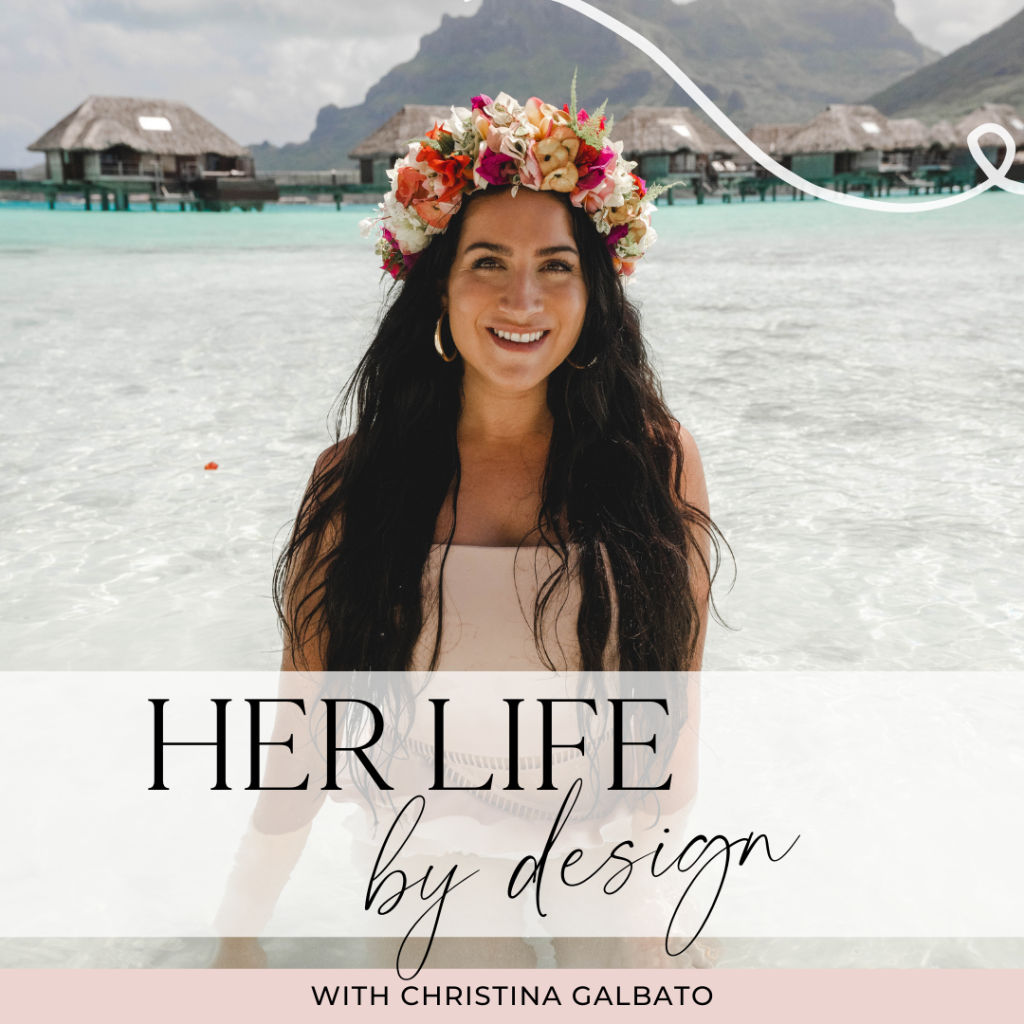
Step 5: Design Your Cover Art
First impressions matter a great deal, which is why having a great podcast cover will help you put your best foot forward. Your podcast’s cover art is your opportunity to entice and attract listeners, so make it count. Although you can spend some money hiring a designer to create your podcast cover art, you can also design one for yourself using Canva. Whichever route you choose to go down, there are a few criterias your podcast cover needs to abide by.
Make sure your cover art is 1400 x 1400 pixels, in either JPG or PNG format. And to optimize it on platforms and directories like Apple Podcasts, Stitcher, and Google Podcasts, your podcast cover needs to be under 500kb in size.
It’s also important to keep in mind that your podcast cover will be viewed by potential listeners on a much smaller scale and format, especially if they’re browsing on their mobile devices. When designing your podcast cover, opt for bolder but simpler design styles. Too much detail and text on your cover art will clutter and confuse any potential listener browsing on their phones.
Step 6: Create Your Intro & Outro
Although this step is optional, having an intro and outro will add a nice professional touch to your podcast. Generally, your intro will include a short piece of music that shouldn’t be longer than a few seconds. You could also include a voiceover that welcomes your listeners to your show. Then, your outro will include the same piece of music that will play your listeners out at the end of each episode.
If an intro and outro is something you want to include in your podcast episodes, the next question you probably have is “where do I find royalty-free music?”
Incompetech is a great place to start if you’re looking for free royalty-free music for your intros and outros. However, the problem with “free” is that most of these audio files can be heard on other podcasts as well.
If you have a little more room budget-wise, a Storyblocks subscription will give you access to a library filled with music and sound effects to choose from. At just $15 a month, you can cancel your subscription anytime, making it worth the price.
Epidemic Sound is another paid option at the same price point ($15 a month) as Storyblocks. Epidemic Sound is a popular music and audio database amongst influencers and content creators. They have a wide selection of music that spans several genres from jazz to pop and everything in between.
Step 7: Choose a Podcast Format
Choosing a format for your podcast largely depends on the people who will be involved in the process. Will you be the only podcast host or will you be joined by a co-host? Does your podcast exclusively feature solo episodes, or will you be interviewing a different guest each episode? Your podcast format can be a combination of interviews, solo episodes, and different format styles. Although you don’t have to stick to a single format, creating a pattern and combination format of your own will help your listeners know what to expect. Here are a few of the most popular podcast format types:
The Solo Show
One of the best things about the solo show format is that you don’t have to rely on anyone else to record and produce your podcast. However, for beginner podcasters, this particular format may seem intimidating. If going solo is your preferred format, keep in mind that you’re not in conversation with yourself, but with your listeners too. Having a bullet point script and outline will help you create a more natural flow when recording solo episodes.
Co-hosted Podcast
Co-hosting a podcast with a friend or colleague is a great format for podcasters who are natural conversationalists. Having a co-host will allow for banter and interesting debates. It can also bring an infectious energy to the show if you and your co-host complement and work well together. However, a major downside to the co-hosted podcast is scheduling, and the sharing of tasks. Striking a balance between what each host is responsible for is key to setting up a great working relationship with your co-host. As for scheduling, find a time that works best for both of you and commit to it on a regular basis.
Interview Format
Inviting thought leaders and experts on your podcast is a great way to deliver valuable content and advice to your listeners. The interview format also opens up opportunities for great collaborations between you and fellow bloggers in your space. Interviewing a guest on your podcast is also a great way for you to gain more listeners. But similar to a co-hosted podcast, scheduling can be a bit of a hassle, especially if you’re new to podcasting. This requires crafting a great podcast pitch that you can send to potential guests ahead of time. Additionally, interviewing is also a skill that takes time and practice. Start small and interview your colleagues and peers within your industry. And don’t start pitching industry leaders and widely-known experts in your field before getting comfortable with your interviewing abilities.

Step 8: Plan Your Episodes
No matter what format you decide to go with, you need to plan your podcast episodes before you start recording. Take some time to plan out the details of each episode. This will help you determine which guests to reach out to, what topics you’ll be covering, and the overall content you’ll be delivering each week. Planning ahead of time will also help you determine what titles you’ll give each podcast episode. If you’re struggling to find topics for your show, revisit your “why” and your target audience. What are some of the most common problems your podcast listeners face? Can you address one issue and provide a solution for them in each podcast episode?
Have a list of at least 10 episode ideas before hitting publish on your podcast. Go over the list and what needs to be addressed in each recording. By doing so, you can estimate the length of each episode, which can then become the baseline model for your podcast length. This list will ensure that you’re prepared and ready to hit record.
Step 9: Determine Your Podcast Schedule
Consistency is key when it comes to producing content for any medium. Whether it’s Instagram, your blog, or a podcast — having a schedule in place will let your audience know when to expect you. This will make it easier for anyone listening to your podcast, even getting them excited for the day a new episode drops. Will you be publishing an episode every week? Or will you be publishing one every other week? No matter what you choose, find a podcast schedule that works with what is currently feasible and realistic for your current workload.

Step 10: Invest in Recording Equipment
Before you’re ready to hit record, you need to invest in recording equipment. The first thing you’ll need is a USB microphone and access to the internet. It’s important to keep sound quality in mind when shopping around for your recording equipment. However, I don’t recommend buying the most expensive gear right away; just in case you realize podcasting isn’t for you.
I use the Blue Yeti USB microphone with a pop cover. It produces a high sound quality thanks to it’s 3 condenser capsules. Best of all, the mic alone costs $150. If you’re looking for a great option that is durable and doesn’t cost a fortune, the Blue Yeti is the way to go.
Once you’ve selected your microphone, you need software to actually record your audio with. If you’re a Mac user, you can always use the built-in Garageband app. However, Audacity is a wildly popular, free-of-charge software that will meet all your podcasting needs. If you’re more seasoned with editing, mixing, and restoring audio — Adobe Audition ($21 per month) has all the bells and whistles you need from a professional audio editing software.
Pro-tip: It doesn’t matter how great your USB microphone is if you’re not speaking directly and clearly into it.
Step 11: Schedule Your Podcast Guests
This step is optional depending on the format of your podcast. But if you plan on interviewing guests on your show, you need to set up a system that makes it easy for you to get the necessary information and marketing assets from each guest. You also need to make sure that your guest is available to record the podcast episode with you by giving them several options.
Set up a system through Calendly that allows your guest to pick from a number of available slots on your calendar. And once they have scheduled a date and time, direct them to an online form that will allow you to collect all the necessary information for the interview, shownotes, and marketing materials.
Typeform or Google Forms is a great platform that allows you to collect any guests’ information through a customized survey. Having a system in place will help you streamline the process of booking and scheduling a recording session with any guest you invite on your podcast.
Step 12: Script Your Show
Opening your show cold takes a lot of skill and confidence. This is why scripting your show is an important part of the process. However, scripting your podcast doesn’t mean writing a word-for-word script that’ll be read on air. That normally never works. For starters, it’s incredibly hard to read a script without sounding like you’re doing just that. Additionally, reading off a script verbatim doesn’t serve you if your podcast follows the interview format.
One of the best things about having a podcast is the intimate nature in which you get to share your thoughts, advice, and stories. When you sit to script your show, think about the major points you want to hit. In an interview setting, this could be a list of questions you want to ask your guest.
Scripting your show often looks like a bullet-pointed outline with all the major topics and questions you’re going to answer throughout the episode. And while the script serves as a great guideline in an interview, don’t be afraid to veer slightly off script to follow the flow of conversation.
Step 13: Edit Your Podcast
If you’re already recording in a program like Audacity, Adobe Audition or even Garageband — you’ll be able to edit your audio files directly in the program. The editing process is where you’ll stitch together your intro, outro, and the main content of your podcast. It’s also where you’ll get rid of any unwanted noises and sounds. Whether you’re trying to edit out some “um’s” or “uh’s,” or even some distracting background noise, any of the 3 above mentioned programs can get the job done.
Similar to Adobe Audition, another editing program — Pro Tools — also offers more advanced editing options. These advanced editing programs will allow you to cleanup, amplify, and equalize any audio file. Although it isn’t necessary to producing and publishing your podcast, it will significantly improve the sound quality of your recording.
But if you find the process of editing audio intimidating and do not have the budget to outsource, use Alitu. This all-in-one platform will take care of processing, editing and publishing your podcast. Although Alitu is priced at $28 per month, It will make the process pain-free and save you lots of time on production.
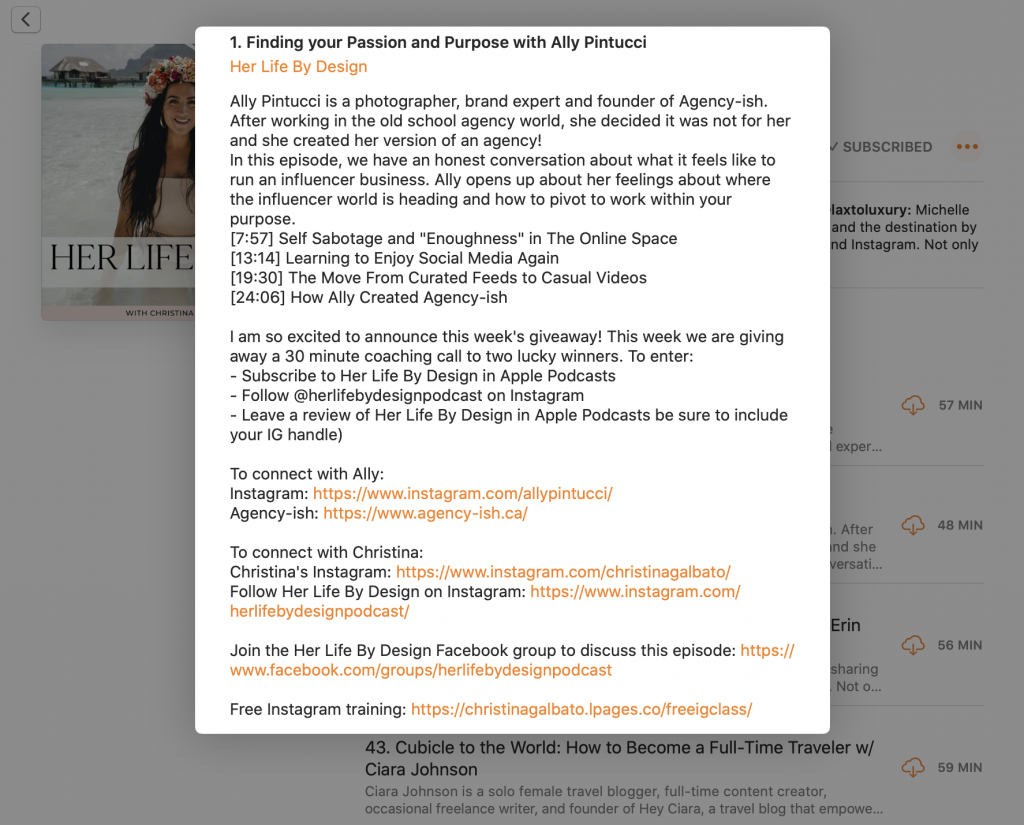
Step 14: Write Shownotes
Including shownotes for each episode is an incredibly important step. Your shownotes will give your readers an idea of what to expect from each episode, persuading new and old listeners to tune in. You can also include specific time stamps of what is discussed throughout the episode. Last but not least, do not forget to add any additional resource links that can help your listeners.

Step 15: Write a Blog Post Summary
To really serve both current and new audiences, write a full-topic summary for your blog. This is an important step especially if you’d like your content to be as accessible as possible. A full-topic summary on your blog will ensure that audiences who might not have time to listen to the entire podcast can catch up on the important discussion. It will also make your podcast content accessible to those who are hard of hearing and unable to tune into the show.
Besides being inclusive, your written summary will help you grow your audience by appearing in Google search results. It is a great growth opportunity considering text searches on Google have a wider reach when compared to podcast searches. By adding an embedded player to the top and bottom of your summary, you’ll encourage new listeners to subscribe to your podcast. Additionally, it’ll give your audiences a document to refer back to if they need to revisit any advice or tips you shared. Saving them the time and effort of skimming through the episode just to find exactly what they need.
Step 16: Select Your Podcast Hosting
Before you share your very first episode, you need to find a podcast or media hosting platform. A common misunderstanding is that you can upload your podcast directly to platforms like Apple Podcasts and Spotify. But that isn’t the case. Before you can submit your podcast to directories (i.e Apple Podcasts), you need to host your podcast, upload your shownotes, and set your podcast cover on a podcast hosting platform. Here are some great hosting options:
- Libsyn – easy to set up and has all the basics starting at $5 per month.
- Buzzsprout – clean interface, statistics, and easy to create websites. There’s a free option available but it’ll delete any previously uploaded episodes after 90 days with a limit of 2 hours of upload time. Paid plans start from $12 a month.
- Podbean – easy to understand analytics and extra Patreon-like services (i.e: paywall for access to certain content). It has a free basic plan for newer podcasters and paid plans start at $9 per month.
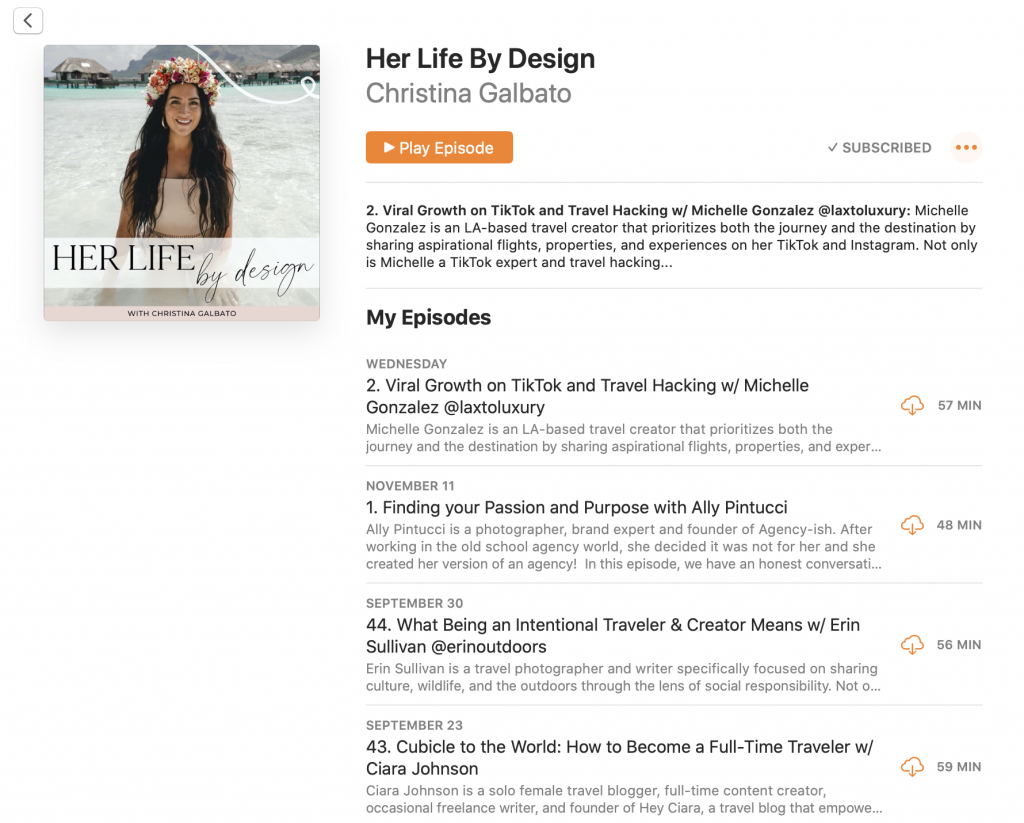
Step 17: Submit Your Podcast to Directories
Once you’re all set up with a podcast hosting platform, you’ll be able to submit your podcast to directories like Apple Podcast, Stitcher, Google Podcasts, and Spotify. These platforms will allow listeners to discover, subscribe, download, and share your show. The podcast hosting platforms listed above either have a set of auto-submit or guided-submission tools. This will make getting your podcast on any of the major directories easy and hassle-free.

Step 18: Promote Your Podcast Episode
Congratulations! You’ve made it this far through this step-by-step guide and your first episode is finally live. Now that it’s available on your selected directories, it’s time for you to promote and announce it to your existing communities. Assuming that you’ve already published the full-topic blog post summary of your podcast episode, it’s time to leverage social media.
Share the episode summary on your blog directly on Pinterest along with Pins directing them to the episode itself. Create audiogram graphics with a short preview of the episode on Headliner and share these graphics on Instagram or Facebook. And if you’re interviewing a guest on your podcast, be sure to email them any social media graphics you create for their episode. That way, they’ll be able to share their interview with their own community, bringing more traffic and awareness to your show.
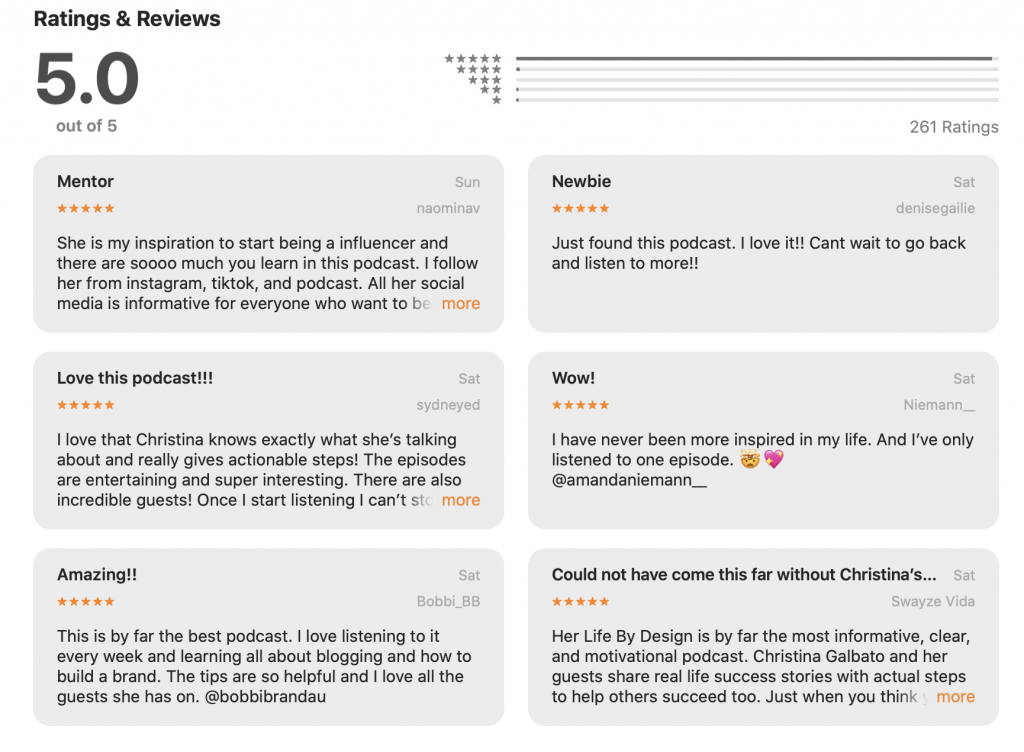
Step 19: Ask Your Listeners to Take Action
When you get into the swing of recording and publishing podcast episodes consistently, you might consider adding an incentive for your audiences to rate and review your show. Their reviews will help you build your community by providing potential listeners with valuable information from other listeners. Furthermore, their reviews will only boost your credibility and authority in your niche and the podcasting space. You can incentivize loyal listeners by featuring a reviewer of the week. Or if you have the budget for it, you could incentivize listeners to leave a rating and review through a series of fun giveaways.
Step 20: Gather Listener Feedback and Implement
Last but not least, it’s important to survey your audience every now and then. Whether you’re reaching out to listeners on your email list or social media following — making sure their opinions are heard is a must. Make a plan to survey your audience every year. Ask them what it is you can improve on and what they’d like to hear more or less of on the show. And if your show involves guests, ask your listeners who they would love to hear from.
If Launching a Podcast is on Your 2021 Vision Board…
The hardest part about starting something new is simply starting. And the internet can be an incredibly overwhelming place especially with a project as ambitious as launching a podcast. If you’re an influencer, blogger, or digital entrepreneur who has “launch podcast” on your 2021 vision board, this step-by-step guide will walk you through everything you need to do for a smooth sailing launch. These are the same steps I followed when I launched my podcast a year ago. And if you follow these same 20 steps, we’ll be listening to your show in no time.




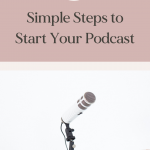


[…] If you’re interested read more about it from Christina Galbato. […]